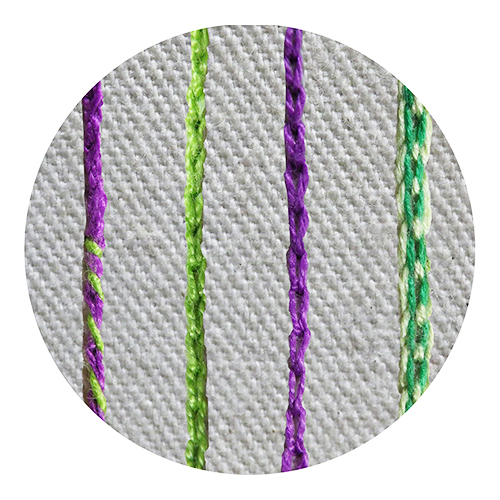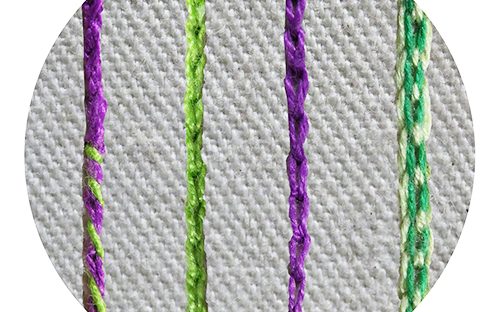
There are varieties of chain stitch in the video clip on this page. They are listed in the table below, in the order is which they appear, with the starting time for each variety in the right-hand column.
| Basic traditional chain stitch | 9 seconds |
| Reverse chain stitch | 48 seconds |
| Chain stitch/backstitch combination | 2 minutes 27 seconds |
| Whipped chain stitch | 3 minutes 28 seconds |
| Whipped chain alternative | 4 minutes 2 seconds |
| Chain stitch circles | 5 minutes 37 seconds |
In the video clip on the tuition page, the small samples were worked with perle no. 5 thread on straight lines. If you wish to experiment with the stitch before you work it onto your project, work on similar lines with similar thread.
The stitch instructions and diagrams appear below, with the video clip at the bottom of the page. If you would like a printable version, click here.
- With a heat erasable pen, draw 6 parallel lines placing them about 10 mm apart.
Working the stitches:
Chain Stitch

Bring the needle up on the line and pull through. Take the needle back into the same hole and come up again where you want the chain stitch to end, loop the thread under the needle and pull through. Staying inside the loop, go back into the same hole, loop the thread under the needle and pull through. Repeat as required and catch the last loop with a small couching stitch.
Chain Stitch – Reverse

Working chain stitch in reverse gives a neater, more controlled result than you will achieve when working it the traditional way. Start with a short straight stitch. Come up on the line slightly further down. Take your needle under the backstitch and go back into same hole. Continue by coming up on the line slightly further down. Take your needle under both threads of the previous loop and go back into same hole. Continue in this way finishing off by just going back into the same hole for the last loop.
Chain Stitch Backstitch Combination

Work a row of chain stitch using shade no. 1. Thereafter, using shade no. 2, work backstitches from the middle of the first chain stitch to the space just before the start of the chain stitch. Follow that with back stitches that start in the middle of the next chain stitch and go into the start of the back stitch in the previous chain stitch. Continue doing backstitch in this way, finishing up on the outside of the last chain stitch. When you do multiple rows of this stitch combination, it is sensible to complete the back stitch in the row before moving onto the next row of chain stitch because it is difficult to see where you should stitch if you have done all of the chain stitch before you start on the backstitch.
Whipped Chain Stitch

To whip chain stitch, bring your needle up adjacent to the beginning of the line of stitching. Take your needle and thread over, then under each stitch. It is advisable to use a tapestry needle when whipping. A contrasting colour thread is often effective.
Whipped Chain Stitch Variation

Work a single line of chain stitch. With a separate whipping thread on a tapestry needle, whip up the side of the chain stitch taking in only the outer (bottom) side of the loop. Work a second row of chain stitch next to the first, making sure that the stitches start and end level with the stitches in the first row of chain stitch. Whip the top side of the loop of the first row and the bottom side of the loop of the second row of chain stitch together with the whipping thread. Continue adding rows of chain stitch in this way, whipping before you start the next row. Whip the top side of the last row of chain stitch to complete.
Chain Stitch Circles

Following the instructions for traditional chain stitch above, work even sized stitches on the line. When you get back to where you started, work the last stitch weaving under the start of the first stitch going back into the hole you came out of and ending off your thread.
And now for the video clip that covers all of the above.
(Don’t forget to click the icon in the bottom right-hand corner to get it to full screen).

